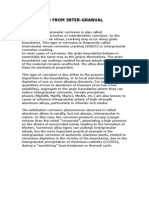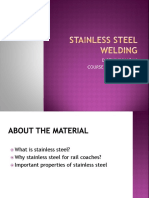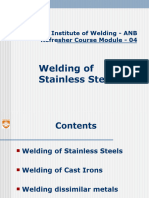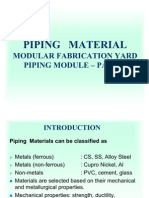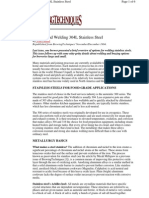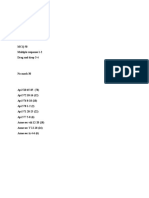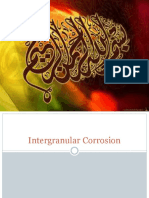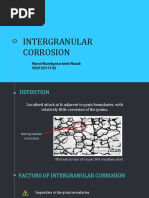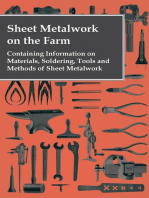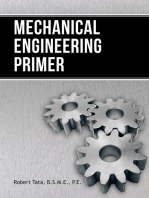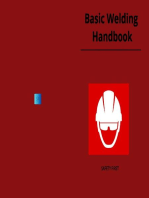The ABC's of Arc Welding: Weld Decay
The ABC's of Arc Welding: Weld Decay
Uploaded by
Lakshmi KanthCopyright:
Available Formats
The ABC's of Arc Welding: Weld Decay
The ABC's of Arc Welding: Weld Decay
Uploaded by
Lakshmi KanthOriginal Description:
Original Title
Copyright
Available Formats
Share this document
Did you find this document useful?
Is this content inappropriate?
Copyright:
Available Formats
The ABC's of Arc Welding: Weld Decay
The ABC's of Arc Welding: Weld Decay
Uploaded by
Lakshmi KanthCopyright:
Available Formats
Weld decay
Weld decay is a corrosion process that mainly occurs as a result of sensitization (regions
susceptible to corrosion) in the heat affected Zones (HAZ) of metal during welding operations.
This process mostly occurs in stainless steels or certain nickel-based alloys. It is a form of
intergranular corrosion.
Means of preventing sensitization:
Solution heat treatment: heating to a temperature above 1900°F (1040°C) followed by
quenching (rapid cooling) in water or quenching oils. During the heating stage the
carbides dissolve and their formation is suppressed by fast cooling.
Lowering concentration of carbon. Sensitization is depressed in low carbon (max. 0.03%)
stainless steels, designated with the suffix L (304L, 316L).
Stabilization by carbide forming elements. Formation of chromium carbides is avoided in
stabilized austenitic stainless steels (321, 347) containing carbide forming elements like
titanium, niobium, tantalum, zirconium. Stabilization heat treatment of such steels results
in preferred formation of carbides of the stabilizing elements instead of chromium
carbides.
The ABC’s of Arc Welding
Weld Decay: Its Cause and Cure
Any stainless stool contains 13% or higher chromium. Because of the large amount of
chromium, stainless steels are kept tree from corrosion due to the chromium oxide forming a
rigid membrane on their surfaces when subjected to such corrosive media as air or oxidizing
acids (e.g. nitric acid). Austenitic stainless steel contains (in addition to chromium) nickel,
molybdenum, and copper to provide the corrosion resistance against non-oxidizing acids
(such as hydrochloric and sulfuric acid) and reducing acids (such as saline solution and
sulfurous acid).
The typical austenitic stainless steel, Type 304 (l8%Cr-8%Ni), is used for a wide range of
applications due to excellent mechanical properties, workability, weldability, in addition to
superior corrosion resistance. However, the weld heat-affected zone of Type 304 may be
attacked by selective corrosion, when it is exposed to a severe corrosive environment. The
attack is called "weld decay," which is caused by intergranular corrosion. Fig. 1 shows weld
decay that occurred on both sides of the seam weld of a 304 pipe of a hot dilute nitric
process.
Fig. 1 — Weld decay occurring on both sides of a 304-pipe weld for a hot diluted
nitric process line (Source: AWS Welding Handbook)
Weld areas are heated at high temperatures in arc welding. Fig. 2 shows the temperature
distribution and the heat-affected zone in a weld.
Fig. 2 — Temperature distribution and the heat-affected zone in a 304 stainless steel
weld
In the carbide precipitation zone (as shown in Fig. 2) chromium combines with carbon and
precipitates chromium carbides at the grain boundaries, depleting the corrosion-resistible,
uncombined chromium at or adjacent to the grain boundaries. This phenomenon is called
"sensitization," because the areas along the grain boundaries become sensitive to corrosion.
In order to control the sensitization of the heat-affected zone, use
(1) 304L or 316L grade, because lower carbon content decreases the carbide precipitation.
(2) 347 or 321 stabilized grade, because stronger carbide-forming elements (Nb or Ti)
prevent the precipitation of chromium carbides.
(3) postweld solution annealing treatment in the temperature range of 1000-1150°C,
followed by rapid cooling, which decomposes the chromium carbides and make the
chromium resistible to corrosion.
You might also like
- Welding of Austenitic Stainless Steel - Part 2 - TWINo ratings yetWelding of Austenitic Stainless Steel - Part 2 - TWI6 pages
- Ch-19 Gas Welding, Gas Cutting - Arc WeldingNo ratings yetCh-19 Gas Welding, Gas Cutting - Arc Welding85 pages
- Ch-19 Gas Welding, Gas Cutting & Arc WeldingNo ratings yetCh-19 Gas Welding, Gas Cutting & Arc Welding122 pages
- Alloy Steels: Table 4.2 Typical Mechanical Properties of Some Commercial Steels at Room TemperatureNo ratings yetAlloy Steels: Table 4.2 Typical Mechanical Properties of Some Commercial Steels at Room Temperature2 pages
- D-Met 04 Welding of Stainless Steels, CI and Dissimilar WeldNo ratings yetD-Met 04 Welding of Stainless Steels, CI and Dissimilar Weld42 pages
- Weld Decay Causes and Prevention (Kobelco Welding) PDFNo ratings yetWeld Decay Causes and Prevention (Kobelco Welding) PDF1 page
- Sensitization: Definition - What Does Sensitization Mean?No ratings yetSensitization: Definition - What Does Sensitization Mean?2 pages
- Heat Treatment and The Effect of Welding: Week 2No ratings yetHeat Treatment and The Effect of Welding: Week 244 pages
- Etc.) - The Number of Grades Is Therefore Seemingly Infinite, With A Large NumberNo ratings yetEtc.) - The Number of Grades Is Therefore Seemingly Infinite, With A Large Number16 pages
- Ch-19 Gas Welding, Gas Cutting & Arc Welding0% (1)Ch-19 Gas Welding, Gas Cutting & Arc Welding184 pages
- Welding of Austenitic Stainless Steel. Part 2: Home Technical Knowledge Job KnowledgeNo ratings yetWelding of Austenitic Stainless Steel. Part 2: Home Technical Knowledge Job Knowledge8 pages
- Material of Construction in ASME Code Pressure VesselsNo ratings yetMaterial of Construction in ASME Code Pressure Vessels7 pages
- Corrosion Guide - Stainless Internation NickelNo ratings yetCorrosion Guide - Stainless Internation Nickel20 pages
- Materials For High Temperature High Pressure Applications andNo ratings yetMaterials For High Temperature High Pressure Applications and28 pages
- Stainless Steel Metallurgy-Manufacturing Process, Grades & Role of Alloying ElementsNo ratings yetStainless Steel Metallurgy-Manufacturing Process, Grades & Role of Alloying Elements35 pages
- Tool Steel Grade and Standard DesignationNo ratings yetTool Steel Grade and Standard Designation7 pages
- Article - Stress Relieving Heat Treatments For Austenitic Stainless SteelsNo ratings yetArticle - Stress Relieving Heat Treatments For Austenitic Stainless Steels2 pages
- Sheet Metalwork on the Farm - Containing Information on Materials, Soldering, Tools and Methods of Sheet MetalworkFrom EverandSheet Metalwork on the Farm - Containing Information on Materials, Soldering, Tools and Methods of Sheet MetalworkNo ratings yet
- Why Do Metals Rust? An Easy Read Chemistry Book for Kids | Children's Chemistry BooksFrom EverandWhy Do Metals Rust? An Easy Read Chemistry Book for Kids | Children's Chemistry BooksNo ratings yet
- Technical Manual - The Blacksmith and the Welder - June 16, 1941From EverandTechnical Manual - The Blacksmith and the Welder - June 16, 1941No ratings yet
- The Working of Steel Annealing, Heat Treating and Hardening of Carbon and Alloy SteelFrom EverandThe Working of Steel Annealing, Heat Treating and Hardening of Carbon and Alloy Steel5/5 (4)
- Heat-Treatment of Steel: A Comprehensive Treatise on the Hardening, Tempering, Annealing and Casehardening of Various Kinds of Steel: Including High-speed, High-Carbon, Alloy and Low Carbon Steels, Together with Chapters on Heat-Treating Furnaces and on Hardness TestingFrom EverandHeat-Treatment of Steel: A Comprehensive Treatise on the Hardening, Tempering, Annealing and Casehardening of Various Kinds of Steel: Including High-speed, High-Carbon, Alloy and Low Carbon Steels, Together with Chapters on Heat-Treating Furnaces and on Hardness Testing1/5 (1)
- Computer Program For Automatic Calculation of Tube Sheet Details in A Heat ExchangerNo ratings yetComputer Program For Automatic Calculation of Tube Sheet Details in A Heat Exchanger7 pages
- Chapter 4: Thermodynamics of Air-Vapour Mixtures Module A: Introduction To ModellingNo ratings yetChapter 4: Thermodynamics of Air-Vapour Mixtures Module A: Introduction To Modelling82 pages
- Multiphase Flows With Compressible and Incompressible PhasesNo ratings yetMultiphase Flows With Compressible and Incompressible Phases14 pages
- Steam & Water Hose Stations & Mixing Units: Safety FeaturesNo ratings yetSteam & Water Hose Stations & Mixing Units: Safety Features1 page
- MST Products: MST That Has Changed The Concept of P/M in A Big Way0% (1)MST Products: MST That Has Changed The Concept of P/M in A Big Way16 pages
- 2 Solar CellSimulation of CZTSSe Thin-Film Solar Cells in COMSOL-2020No ratings yet2 Solar CellSimulation of CZTSSe Thin-Film Solar Cells in COMSOL-20206 pages
- MR Mukim 1600x1800 1100x1300 700mm 9stops 450kg 1MNo ratings yetMR Mukim 1600x1800 1100x1300 700mm 9stops 450kg 1M1 page
- FME 8 - Material Science and Engineering For ME: Prepared By: Engr. Adrian Agonos, ME, RMPNo ratings yetFME 8 - Material Science and Engineering For ME: Prepared By: Engr. Adrian Agonos, ME, RMP61 pages
- Engineering Structures: Ke Wang, Ben Young, Scott T. SmithNo ratings yetEngineering Structures: Ke Wang, Ben Young, Scott T. Smith8 pages
- 1 5 To 2 Ton ZP Ka R 410a Copeland Scroll Compressors For Air Conditioning en Us 160826No ratings yet1 5 To 2 Ton ZP Ka R 410a Copeland Scroll Compressors For Air Conditioning en Us 16082616 pages
- A/C System Diagnosis Using Superheat & Sub-Cooling MeasurementsNo ratings yetA/C System Diagnosis Using Superheat & Sub-Cooling Measurements7 pages
- Fluid Mechanics: Instructions To CandidatesNo ratings yetFluid Mechanics: Instructions To Candidates2 pages
- SECTION 16112 Busway Part 1 - General 1.1 DescriptionNo ratings yetSECTION 16112 Busway Part 1 - General 1.1 Description4 pages
- 1ZSP000003 Hitachi Energy - Composite Station Post Insulators-WebNo ratings yet1ZSP000003 Hitachi Energy - Composite Station Post Insulators-Web6 pages
- Welding of Austenitic Stainless Steel - Part 2 - TWIWelding of Austenitic Stainless Steel - Part 2 - TWI
- Alloy Steels: Table 4.2 Typical Mechanical Properties of Some Commercial Steels at Room TemperatureAlloy Steels: Table 4.2 Typical Mechanical Properties of Some Commercial Steels at Room Temperature
- D-Met 04 Welding of Stainless Steels, CI and Dissimilar WeldD-Met 04 Welding of Stainless Steels, CI and Dissimilar Weld
- Weld Decay Causes and Prevention (Kobelco Welding) PDFWeld Decay Causes and Prevention (Kobelco Welding) PDF
- Sensitization: Definition - What Does Sensitization Mean?Sensitization: Definition - What Does Sensitization Mean?
- Etc.) - The Number of Grades Is Therefore Seemingly Infinite, With A Large NumberEtc.) - The Number of Grades Is Therefore Seemingly Infinite, With A Large Number
- Welding of Austenitic Stainless Steel. Part 2: Home Technical Knowledge Job KnowledgeWelding of Austenitic Stainless Steel. Part 2: Home Technical Knowledge Job Knowledge
- Material of Construction in ASME Code Pressure VesselsMaterial of Construction in ASME Code Pressure Vessels
- Materials For High Temperature High Pressure Applications andMaterials For High Temperature High Pressure Applications and
- Stainless Steel Metallurgy-Manufacturing Process, Grades & Role of Alloying ElementsStainless Steel Metallurgy-Manufacturing Process, Grades & Role of Alloying Elements
- Article - Stress Relieving Heat Treatments For Austenitic Stainless SteelsArticle - Stress Relieving Heat Treatments For Austenitic Stainless Steels
- Sheet Metalwork on the Farm - Containing Information on Materials, Soldering, Tools and Methods of Sheet MetalworkFrom EverandSheet Metalwork on the Farm - Containing Information on Materials, Soldering, Tools and Methods of Sheet Metalwork
- Why Do Metals Rust? An Easy Read Chemistry Book for Kids | Children's Chemistry BooksFrom EverandWhy Do Metals Rust? An Easy Read Chemistry Book for Kids | Children's Chemistry Books
- Technical Manual - The Blacksmith and the Welder - June 16, 1941From EverandTechnical Manual - The Blacksmith and the Welder - June 16, 1941
- The Working of Steel Annealing, Heat Treating and Hardening of Carbon and Alloy SteelFrom EverandThe Working of Steel Annealing, Heat Treating and Hardening of Carbon and Alloy Steel
- Heat-Treatment of Steel: A Comprehensive Treatise on the Hardening, Tempering, Annealing and Casehardening of Various Kinds of Steel: Including High-speed, High-Carbon, Alloy and Low Carbon Steels, Together with Chapters on Heat-Treating Furnaces and on Hardness TestingFrom EverandHeat-Treatment of Steel: A Comprehensive Treatise on the Hardening, Tempering, Annealing and Casehardening of Various Kinds of Steel: Including High-speed, High-Carbon, Alloy and Low Carbon Steels, Together with Chapters on Heat-Treating Furnaces and on Hardness Testing
- Computer Program For Automatic Calculation of Tube Sheet Details in A Heat ExchangerComputer Program For Automatic Calculation of Tube Sheet Details in A Heat Exchanger
- Chapter 4: Thermodynamics of Air-Vapour Mixtures Module A: Introduction To ModellingChapter 4: Thermodynamics of Air-Vapour Mixtures Module A: Introduction To Modelling
- Multiphase Flows With Compressible and Incompressible PhasesMultiphase Flows With Compressible and Incompressible Phases
- Steam & Water Hose Stations & Mixing Units: Safety FeaturesSteam & Water Hose Stations & Mixing Units: Safety Features
- MST Products: MST That Has Changed The Concept of P/M in A Big WayMST Products: MST That Has Changed The Concept of P/M in A Big Way
- 2 Solar CellSimulation of CZTSSe Thin-Film Solar Cells in COMSOL-20202 Solar CellSimulation of CZTSSe Thin-Film Solar Cells in COMSOL-2020
- MR Mukim 1600x1800 1100x1300 700mm 9stops 450kg 1MMR Mukim 1600x1800 1100x1300 700mm 9stops 450kg 1M
- FME 8 - Material Science and Engineering For ME: Prepared By: Engr. Adrian Agonos, ME, RMPFME 8 - Material Science and Engineering For ME: Prepared By: Engr. Adrian Agonos, ME, RMP
- Engineering Structures: Ke Wang, Ben Young, Scott T. SmithEngineering Structures: Ke Wang, Ben Young, Scott T. Smith
- 1 5 To 2 Ton ZP Ka R 410a Copeland Scroll Compressors For Air Conditioning en Us 1608261 5 To 2 Ton ZP Ka R 410a Copeland Scroll Compressors For Air Conditioning en Us 160826
- A/C System Diagnosis Using Superheat & Sub-Cooling MeasurementsA/C System Diagnosis Using Superheat & Sub-Cooling Measurements
- SECTION 16112 Busway Part 1 - General 1.1 DescriptionSECTION 16112 Busway Part 1 - General 1.1 Description
- 1ZSP000003 Hitachi Energy - Composite Station Post Insulators-Web1ZSP000003 Hitachi Energy - Composite Station Post Insulators-Web

